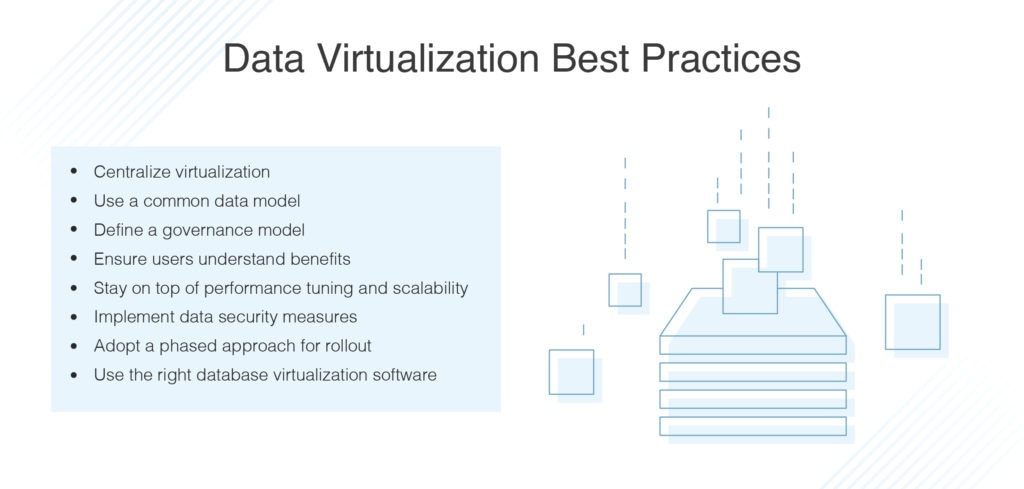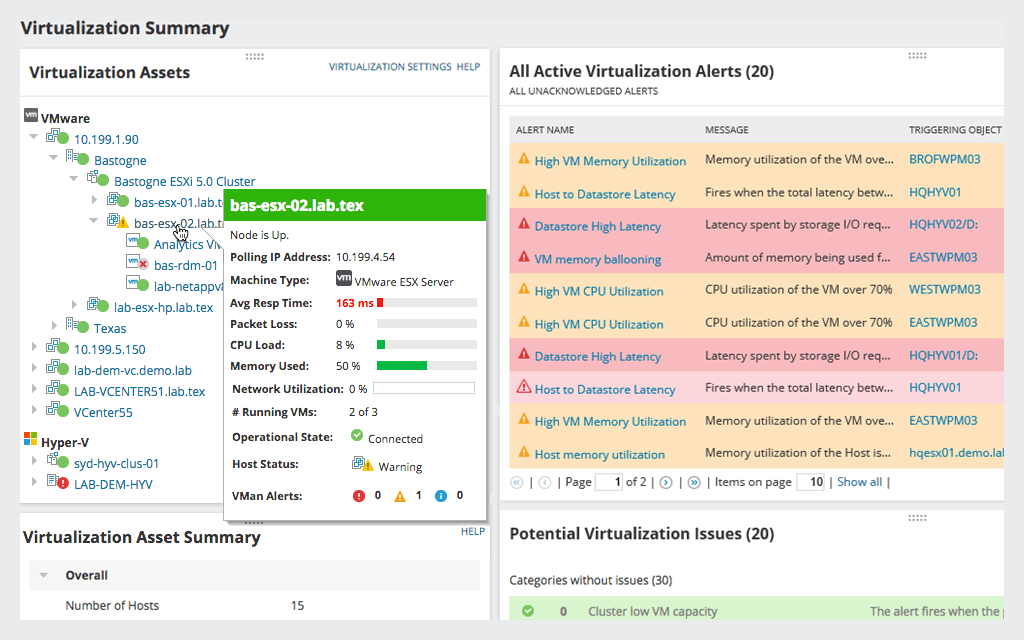Database virtualization is a challenging subject, and new IT professionals might find it difficult to understand at first. This difficulty is at least partially because database virtualization can be interpreted in different ways. For example, database virtualization might be thought of as running the database in a virtual machine using virtualized storage or as a fully virtualized elastic database cluster composed of modular compute and storage components, which are assembled to accommodate your individual database requirements.

This guide covers the basics of database virtualization and outlines the top database virtualization best practices for 2022. It also recommends one of the best database virtualization tools currently on the market, SolarWinds® Virtualization Manager (VMAN). VMAN is user-friendly and advanced database virtualization software designed for beginners and experts alike. A 30-day free trial is available.
What Is Database Virtualization?
Database virtualization is best described as abstracting from physical resources (i.e., data, RAM, and compute) to the logical representation. This supports the following database frameworks:
- Many-to-one: This refers to many database nodes acting as one logical database.
- One-to-many: This refers to one logical database split across multiple nodes.
- Many-to-many: This occurs when multiple records in a table are associated with multiple records in another table.
Standard database virtualization should perform the following functions:
- Database virtualization should enable the application to communicate with a single virtual instance of the database, despite there being multiple nodes acting over the data.
- Database virtualization should separate the data processing (CPU) from the data (I/O) to ensure each can scale independently of one another and on demand.
- To facilitate high performance, database virtualization should enable the actual processing of data to be distributed to multiple nodes on the storage tier.
- Database virtualization should provide tiered caching, for performance purposes, while ensuring cache coherence exists across the entire cluster.
Database virtualization is more than simply running a database management system (DBMS) in a virtual machine. Running a DBMS in a virtual machine comes with disadvantages, but it’s not necessarily database virtualization. Standard databases fuse together the data with the processing to operate as one unit. Running that unit in a virtual machine won’t give you access to the benefits associated with database virtualization (which will be outlined later in this guide). This process is server virtualization, not database virtualization.
Why Might You Need a Virtual Database?
A virtual database is a type of database management system that acts as a container, allowing you to view and query multiple databases through a single API drawing from numerous sources as if they were an individual entity. These databases are connected through a computer network and accessible as if they are sourced from one database. The goal of a virtual database is to allow users to view and access data in a unified way, without the need to copy and duplicate it into multiple databases or manually combine query results.
How Do Virtual Databases Work?
In a virtualized database, each of the combined databases in the system is entirely functional and self-sustaining and can function by itself without depending on other existing databases. If an application requests access to a virtual database, the system will determine which of the databases contained within it is storing the data requested. The request is passed onto the appropriate database. When building a virtual database, the most challenging part is creating a universal data model, which acts as the guide to every source of data within the organization.
Database Virtualization Benefits
By incorporating multiple databases into a centralized container, virtual databases provide several benefits:
Alternative Merging Technique
One of the main advantages of virtual databases is they serve as an alternative merging technique for numerous databases, which is a challenging task for most end users.
Avoiding Tight Connection of Applications
Virtual databases, by removing vendor and scheme lock-in, assist developers by allowing them to avoid the tight connection of applications. Applications simply need to be connected to the virtual database to access multiple databases.
Higher Server Utilization
When data is fused to the CPU as an individual unit, a single node is responsible for managing all usage spikes for its data collection. The data is split across multiple servers, forcing you to run each server at a low rate of utilization. Database virtualization decouples the data from the processing, which means usage spikes can be shared across multiple nodes when necessary. In other words, you can run a virtualized database at a very high rate of utilization.
Lower Infrastructure Costs
Database virtualization can help you avoid costly investments in extra servers, operating systems, power, application licenses, network switches, tools, and storage.
Lower Labor Costs
Database virtualization makes the database administrator’s job easier because it uses one schema and requires zero sharding. It also simplifies the backup process, allowing the database administrator to manage more databases. Database virtualization reduces the application developer’s responsibilities by eliminating code related to sharding.
Less Complexity
With database virtualization, you only have one database image, so scaling up or down is fast and simple.
Quality of Service
Database images can move on the fly, without any downtime, which means a noisy network can be solved simply by moving the database to another node.
Availability
Unlike typical databases, virtual database nodes can see all the data, which allows them to provide failover for one another, reducing unplanned downtime. With planned downtime, processes can simply be moved to another server. This means you can take down the server in need of service without causing any disruption.
Greater Flexibility
Database virtualization affords users the same flexibility to the database that server virtualization brings to the application tier. Resources can be allocated and reallocated as needed. If your usage profile changes, a virtual database uses the same shared infrastructure for any workload type, which is not something a traditional database can achieve.
Improved Performance
The pooled cache across the storage tier uses an algorithm based on Least Recently Used (LRU). This allows virtual databases to free up a significant amount of pooled cache, enabling near in-memory performance. The distribution of processing to the storage tier allows you to achieve high-performance parallel processing.
Database Virtualization Best Practices
To achieve successful database virtualization, you should implement the following database virtualization best practices:
Centralization
Centralize data virtualization responsibility. This allows you to advance the data and database virtualization process quickly, so you can tackle other challenges, like implementing an intelligent storage component and defining common canonicals.
Common Data Model
Decide on a common data model and implement it. Doing this ensures consistent and high-quality data, inspiring user confidence in the data and helping your IT staff become more productive and agile.
Governance Model
Define a governance model. A successful governance model should include guidelines for how the database virtualization environment should be managed. The governance model should also state who is responsible for shared services and shared infrastructure.
Clear Benefits
Ensure relevant parties understand the benefits of database virtualization. This should involve allocating time to consult with business users to ensure they understand the data available to them. Establish an ongoing effort to make data virtualization and database virtualization acceptable to other areas of the company.
Tuning
Stay on top of performance tuning and scalability. You should tune performance and test solution scalability early in the development process, and in an ongoing capacity. You might consider implementing massively parallel processing capabilities to accommodate query performance on a high volume of data. Remember users are unpredictable when performing ad hoc analysis and reporting.
Data Security
Don’t overlook data security, as data virtualization makes it easier to expose a greater breadth of data to more users. If data is exposed to new user types, for example, your data security protocols will help you determine which types of regulations might apply.
Phased Approach
Adopt a phased approach to implementing database virtualization. This complicated process should be carefully planned before being rolled out.
Choosing the Right Database Virtualization Software
If you’re looking for enterprise-grade database virtualization tools, then SolarWinds VMAN is a scalable and user-friendly option. This tool allows you to monitor VMware, Nutanix, and Hyper-V issues with robust and extensive virtualization management capabilities. VMAN helps you streamline thousands of counters and metrics into one intuitive user interface. With built-in dashboards, reports, and intelligent alerting, VMAN can provides an immediate return on investment. This solution features numerous customization options, allowing you to tune the tool to your individual virtualization management requirements.

VMAN is built to monitor storage vendors, configurations, and models across your virtualized environment, combining data into a single interface. The database virtualization software lets you deactivate a virtual device or reallocate resources to free up IOPs and latency for the additional virtual devices sharing a storage resource. This feature helps you improve virtual machine performance problems rapidly.
VMAN can also be used for capacity planning purposes, which is especially useful for companies anticipating expansion or growth. Capacity planning lets you use data and trends from your own virtualized environment to project future resource growth and requirements. The capacity planning feature was designed to help you predict memory, CPU, network, and storage needs for your VMware vSphere and Microsoft Hyper-V environments. VMAN can give you access to current virtual machine growth and resource constraint statistics, so you can easily determine hardware purchase needs. VMAN can be used to model future server and hardware additions, giving insight into whether your environment will be able to scale to meet workload needs.
This solution makes it easy to view consumption trends, helping you determine outage dates and resource warnings. You can also customize the sample timeframe to create individual capacity plans for non-peak and peak usage.
VMAN helps you test virtualization capacity with modeling scenarios. This means you can run “what-if” modeling scenarios, such as accessing existing virtual machines and host usage, to gain insight into the effects of one or more hosts going down. You can also use VMAN to determine whether your virtual machine will run smoothly or not, because it allows you to view what resources are likely to experience a bottleneck if there’s a device failure. You can accurately determine how it might impact your environment if resources or additional hosts are added. VMAN helps you understand how to load balance your environment to achieve capacity efficiency and improved virtual machine performance.
VMAN offers a Hyper-V capacity planning tool which helps you determine the best location for your virtual machines. The VMAN tools are built to average resources by clusters and compare cluster-by-cluster resource constraints. This feature assists you in determining the ideal location for future workload placement. VMAN also features built-in virtual machine performance visualization tools, including scatter plot graphs. These visualizations can show you latency and IOPS for current virtual machines, and display storage expectations for future workloads.
SolarWinds VMAN is a highly user-friendly solution with a low initial learning curve. It is well-supported by the vendor, with 24/7 support technician availability.
Getting Started With Database Virtualization
Database virtualization brings with it an array of benefits, including improved performance, greater flexibility, less complexity, higher availability, lower labor costs, and much more. To make the most of these database virtualization benefits, implement the database virtualization best practices mentioned in this guide. Database virtualization software like SolarWinds VMAN can help you implement database virtualization best practices and maximize the benefits of database virtualization, while increasing your team’s overall productivity. To take advantage of a 30-day free trial of SolarWinds VMAN, click here.
